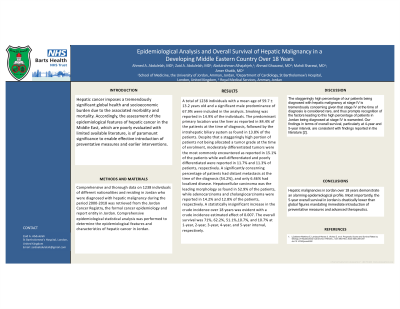Sunday Poster Session
Category: Liver
P0945 - Epidemiological Analysis and Overall Survival of Hepatic Malignancy in a Developing Middle Eastern Country Over 18 Years
Sunday, October 22, 2023
3:30 PM - 7:00 PM PT
Location: Exhibit Hall

Has Audio

Zaid A. Abdulelah, MD
St Bartholomew's Hospital
Cambridge, England, United Kingdom
Presenting Author(s)
Ahmed A. Abdulelah, MD1, Zaid A. Abdulelah, MD2, Abdulrahman Alhajahjeh, 3, Ahmad Ghazzawi, MD1, Mahdi Sharawi, MD1, Amer Khatib, MD1
1School of Medicine, The University of Jordan, Amman, 'Amman, Jordan; 2St Bartholomew's Hospital, London, England, United Kingdom; 3University of Jordan School of Medicine, Amman, 'Amman, Jordan
Introduction: Hepatic cancer imposes a tremendously significant global health and socioeconomic burden due to the associated morbidity and mortality. Accordingly, the assessment of the epidemiological features of hepatic cancer in the Middle East, which are poorly evaluated with limited available literature, is of paramount significance to enable effective introduction of preventative measures and earlier interventions.
Methods: Comprehensive and thorough data on 1238 individuals of different nationalities and residing in Jordan who were diagnosed with hepatic malignancy during the period 2000-2018 was retrieved from the Jordan Cancer Registry, the formal cancer epidemiology and report entity in Jordan. Comprehensive epidemiological statistical analysis was performed to determine the epidemiological features and characteristics of hepatic cancer in Jordan.
Results: A total of 1238 individuals with a mean age of 59.7 ± 13.2 years old and a significant male predominance of 67.9% were included in the analysis. Smoking was reported in 14.9% of the individuals. The predominant primary location was the liver as reported in 84.4% of the patients at the time of diagnosis, followed by the intrahepatic biliary system as found in 13.8% of the patients. Despite that a staggeringly high portion of patients not being allocated a tumor grade at the time of enrollment, moderately differentiated tumors were the most commonly encountered as reported in 15.1% of the patients while well-differentiated and poorly differentiated were reported in 11.7% and 11.3% of patients, respectively. A significantly concerning percentage of patients had distant metastasis at the time of the diagnosis (54.2%), and only 6.46% had localized disease. Hepatocellular carcinoma was the leading morphology as found in 52.9% of the patients, while adenocarcinoma and cholangiocarcinoma were reported in 14.2% and 12.8% of the patients, respectively. A statistically insignificant increase in the crude incidence over 18 years was evident with a crude incidence estimated effect of 0.007. The overall survival was 71%, 62.2%, 51.1%,10.7%, and 10.7% at 1-year, 2-year, 3-year, 4-year, and 5-year interval, respectively.
Discussion: Hepatic malignancies in Jordan over 18 years demonstrate an alarming epidemiological profile. Most importantly, the 5-year overall survival in Jordan is drastically lower than global figures mandating immediate introduction of preventative measures and advanced therapeutics.
Disclosures:
Ahmed A. Abdulelah, MD1, Zaid A. Abdulelah, MD2, Abdulrahman Alhajahjeh, 3, Ahmad Ghazzawi, MD1, Mahdi Sharawi, MD1, Amer Khatib, MD1. P0945 - Epidemiological Analysis and Overall Survival of Hepatic Malignancy in a Developing Middle Eastern Country Over 18 Years, ACG 2023 Annual Scientific Meeting Abstracts. Vancouver, BC, Canada: American College of Gastroenterology.
1School of Medicine, The University of Jordan, Amman, 'Amman, Jordan; 2St Bartholomew's Hospital, London, England, United Kingdom; 3University of Jordan School of Medicine, Amman, 'Amman, Jordan
Introduction: Hepatic cancer imposes a tremendously significant global health and socioeconomic burden due to the associated morbidity and mortality. Accordingly, the assessment of the epidemiological features of hepatic cancer in the Middle East, which are poorly evaluated with limited available literature, is of paramount significance to enable effective introduction of preventative measures and earlier interventions.
Methods: Comprehensive and thorough data on 1238 individuals of different nationalities and residing in Jordan who were diagnosed with hepatic malignancy during the period 2000-2018 was retrieved from the Jordan Cancer Registry, the formal cancer epidemiology and report entity in Jordan. Comprehensive epidemiological statistical analysis was performed to determine the epidemiological features and characteristics of hepatic cancer in Jordan.
Results: A total of 1238 individuals with a mean age of 59.7 ± 13.2 years old and a significant male predominance of 67.9% were included in the analysis. Smoking was reported in 14.9% of the individuals. The predominant primary location was the liver as reported in 84.4% of the patients at the time of diagnosis, followed by the intrahepatic biliary system as found in 13.8% of the patients. Despite that a staggeringly high portion of patients not being allocated a tumor grade at the time of enrollment, moderately differentiated tumors were the most commonly encountered as reported in 15.1% of the patients while well-differentiated and poorly differentiated were reported in 11.7% and 11.3% of patients, respectively. A significantly concerning percentage of patients had distant metastasis at the time of the diagnosis (54.2%), and only 6.46% had localized disease. Hepatocellular carcinoma was the leading morphology as found in 52.9% of the patients, while adenocarcinoma and cholangiocarcinoma were reported in 14.2% and 12.8% of the patients, respectively. A statistically insignificant increase in the crude incidence over 18 years was evident with a crude incidence estimated effect of 0.007. The overall survival was 71%, 62.2%, 51.1%,10.7%, and 10.7% at 1-year, 2-year, 3-year, 4-year, and 5-year interval, respectively.
Discussion: Hepatic malignancies in Jordan over 18 years demonstrate an alarming epidemiological profile. Most importantly, the 5-year overall survival in Jordan is drastically lower than global figures mandating immediate introduction of preventative measures and advanced therapeutics.
Disclosures:
Ahmed A. Abdulelah indicated no relevant financial relationships.
Zaid A. Abdulelah indicated no relevant financial relationships.
Abdulrahman Alhajahjeh indicated no relevant financial relationships.
Ahmad Ghazzawi indicated no relevant financial relationships.
Mahdi Sharawi indicated no relevant financial relationships.
Amer Khatib indicated no relevant financial relationships.
Ahmed A. Abdulelah, MD1, Zaid A. Abdulelah, MD2, Abdulrahman Alhajahjeh, 3, Ahmad Ghazzawi, MD1, Mahdi Sharawi, MD1, Amer Khatib, MD1. P0945 - Epidemiological Analysis and Overall Survival of Hepatic Malignancy in a Developing Middle Eastern Country Over 18 Years, ACG 2023 Annual Scientific Meeting Abstracts. Vancouver, BC, Canada: American College of Gastroenterology.
